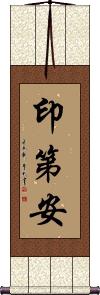Many custom options...
And formats...

Not what you want?
Try other similar-meaning words, fewer words, or just one word.
Feel free to email me with your request. If it's easy, I'll translate it for free and add it to this database of calligraphy for you.
Native American Indian in Chinese / Japanese...
Buy a Native American Indian calligraphy wall scroll here!
Native American / Indian
印第安 is the Chinese title for (American) Indian or Native American.
For disambiguation, this refers only to the indigenous people of North America.
印第安 is a transliteration, so it is meant to sound like the English word “Indian” using Chinese sounds.
This is not a common selection for a calligraphy wall scroll.
Not the results for Native American Indian that you were looking for?
Below are some entries from our dictionary that may match your Native American Indian search...
| Characters If shown, 2nd row is Simp. Chinese |
Pronunciation Romanization |
Simple Dictionary Definition |
印第安 see styles |
yìn dì ān yin4 di4 an1 yin ti an |
More info & calligraphy: Native American / Indian |
印地安 see styles |
yìn dì ān yin4 di4 an1 yin ti an |
(Tw) (American) Indian; native American; indigenous peoples of the Americas; also written 印第安[Yin4 di4 an1] |
北米土人 see styles |
hokubeidojin / hokubedojin ほくべいどじん |
(sometimes derog.) American Indian; native American |
Variations: |
indian(p); indean インディアン(P); インデアン |
(1) (See アメリカインディアン) (American) Indian; Native American; (can act as adjective) (2) (See インド) Indian |
Variations: |
amerikaindian; amerika indian アメリカインディアン; アメリカ・インディアン |
(See ネイティブアメリカン) American Indian; Native American |
The following table may be helpful for those studying Chinese or Japanese...
| Title | Characters | Romaji (Romanized Japanese) | Various forms of Romanized Chinese | |
| Native American Indian | 印第安 | yìn dì ān yin4 di4 an1 yin di an yindian | yin ti an yintian |
|
Successful Chinese Character and Japanese Kanji calligraphy searches within the last few hours...




